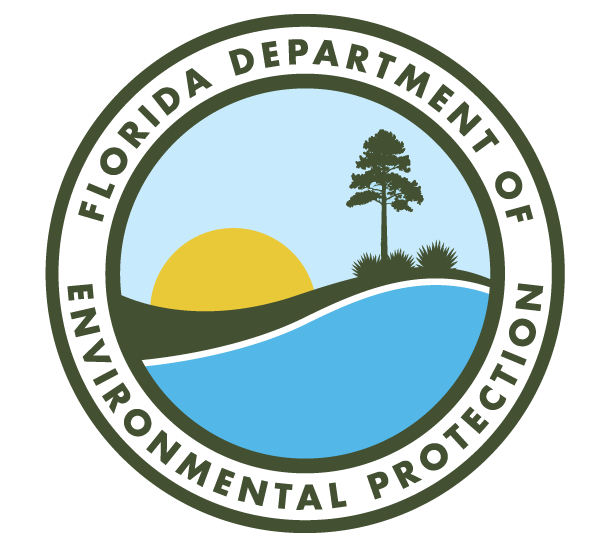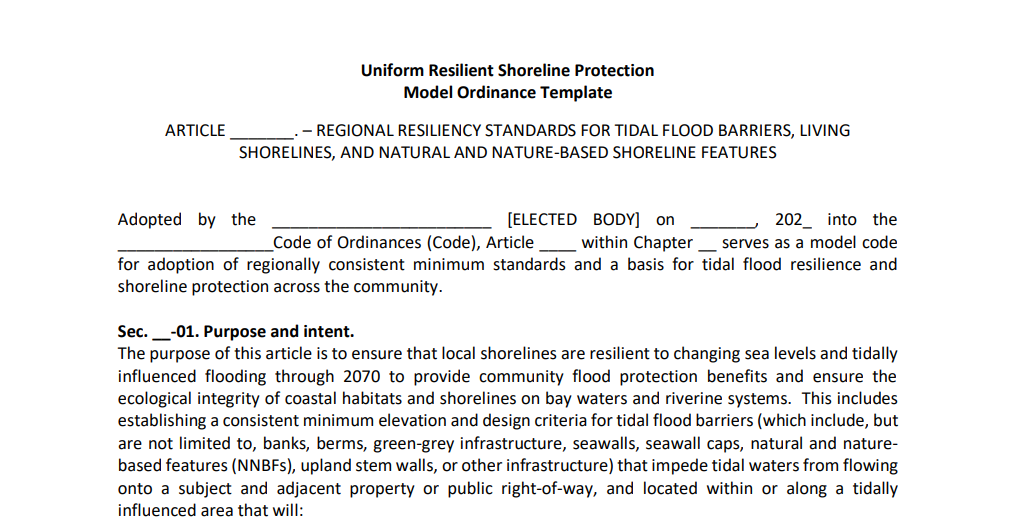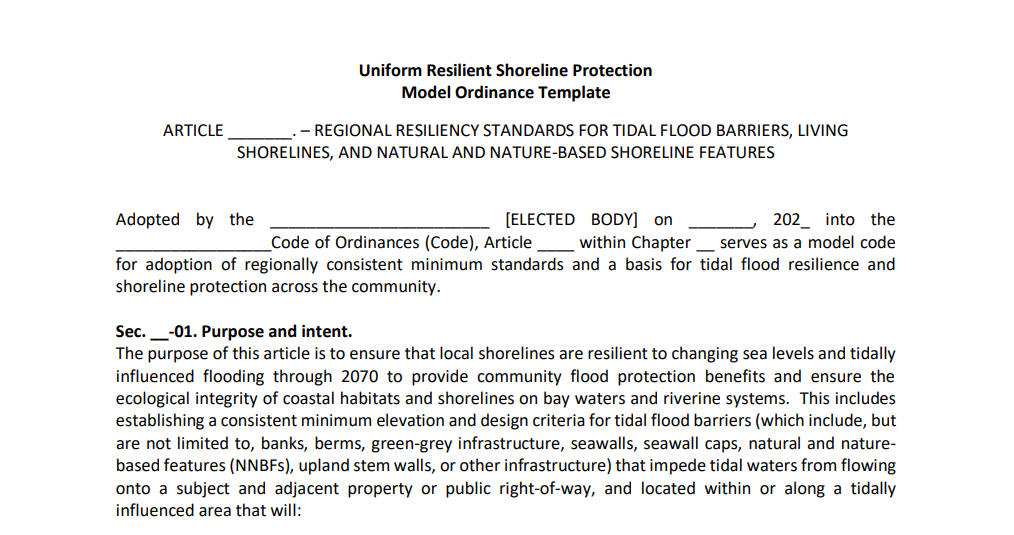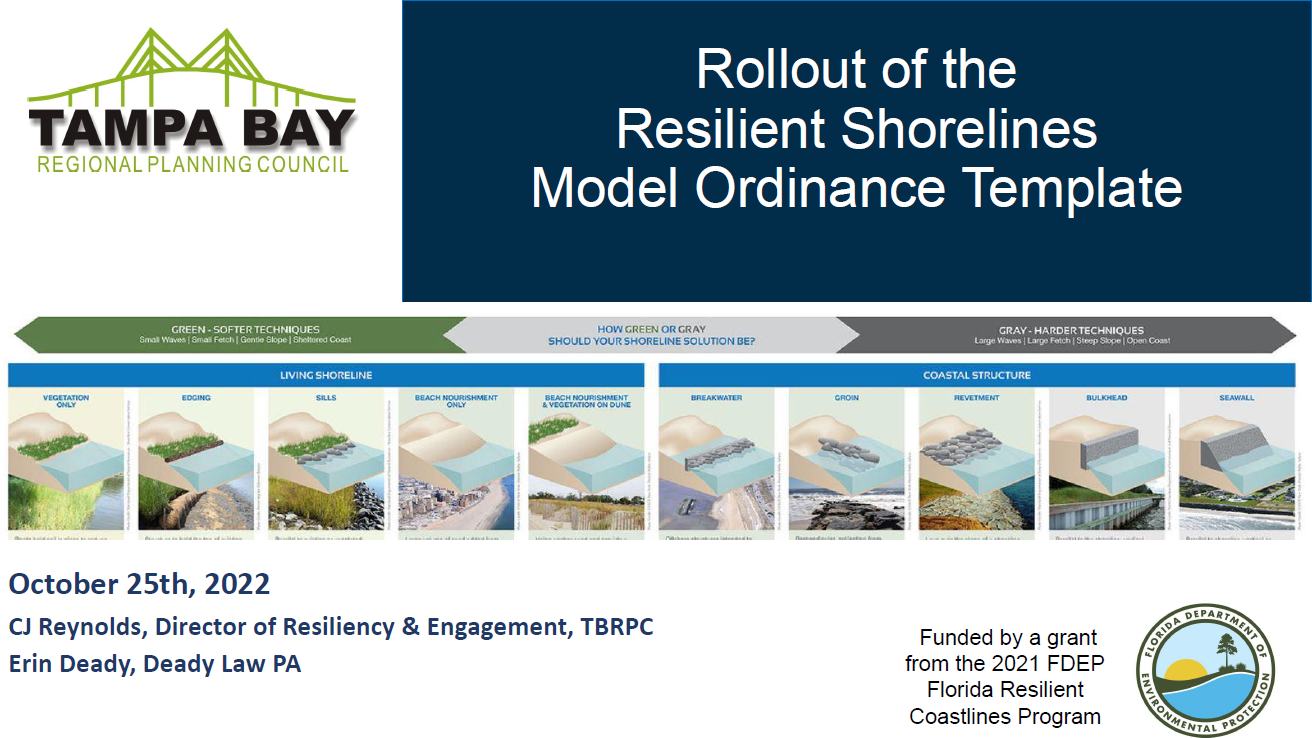Resilient Shoreline Model Ordinance
Home > Resiliency > Resilient Shorelines Model Ordinance
Next meeting:
Funded by the Florida Department of Environmental Protection Resilient Florida program

Resilient Shoreline Model Ordinance Template Released by Council
At the September 12, 2022, TBRPC Council meeting, staff provided a report on key standards and language in the Resilient Shoreline Model Ordinance to Council Members. After a robust discussion, a motion was made, seconded and unanimously passed by the full Council to “Accept the report and authorize the Executive Director to forward the Ordinance Template and Cover Memorandum to the Tampa Bay Regional Resiliency Coalition (TBRRC) and local governments as a resource for their consideration.”
The TBRPC created a Resilient Shoreline Model Ordinance template to support local governments when they make updates to local plans and ordinances related to shoreline protection. The template was developed over two years with extensive input from stakeholders and experts in coastal engineering, marine construction, shoreline ecology, environmental resources management, flood plain management, climate science, land-use policy, permitting and real estate.
Local governments may use the document and give consideration to adopting the model ordinance, or any of the recommendations found within the document at the discretion of their local government.
Updated Model Ordinance 10/26/2022
Shoreline Ordinance Rollout Webinar
On October 25th, 2022, Tampa Bay Regional Planning Council held a webinar to rollout the new Resilient Shorelines Model Ordinance template. TBRPC staff and project team subcontractor Erin Deady, Deady PA reviewed the key sections of the ordinance and answered questions.
Uniform Model Ordinance Supports Local Shoreline Policy
While many jurisdictions have policy for seawalls or comp plans that encourage living shorelines, very few have language which recognizes the need to define an integrated continuum and hierarchy of coastal protection projects.
The new Resilient Shoreline Model Ordinance template is one the first of its kind in the state to define an integrated set of policies to ensure that all types of shoreline protection strategies are designed to be resilient to changing sea levels and tidally influenced flooding through 2070, using best practices. It also considers both community flood protection benefits and ecological integrity of coastal habitats and shorelines on bay waters and riverine systems.
To support inter-jurisdictional consistency on resilience, as defined in the Resiliency Coalition Memorandum of Understanding, the template establishes a minimum elevation of five (5) feet NAVD 88 to account for projected sea level rise in combination with high tides by 2070.
The ordinance establishes shoreline type standards, a coordinated policy for protecting and preserving natural shorelines, promoting living and hybrid shorelines, and defining appropriate locations and land-use types for implementing seawalls and hardened structures.
The section which defines a helpful seawall/bulkhead permitting process uses criteria defined in the Florida Environmental Resource Permit Applicant’s Handbook Volume 1, December 2, 2020, approved by the Florida Department of Environmental Protection (FDEP) and all five water management districts.
The template will help local governments streamline their review and approval processes. If locally adopted, it will provide crucial guidance to property owners and contractors to create shoreline projects that increase community resilience and improve local habitats and water quality.
The development of the model ordinance template was supported by a grant from the Florida Department of Environmental Protection and included land-use policy.
The ordinance is not applicable to oceanfront beaches, passes, inlets or shorelines seaward of the Coastal Construction Control Line.
Project Background
In 2019, at the direction of the TBRPC Council Chair Jack Mariano and the Tampa Bay Regional Resilience Coalition Steering Committee, the TBRPC established a Resilient Shorelines and Spaces working group. The workgroup met four times and defined core issues that local governments and property owners were experiencing. The group also identified the need for documents to support updates to local Comprehensive Plans, Codes and other programs which included new best practices for shorelines and established a uniform shoreline policy guidance and language for sea level rise.
In 2020, TBRPC asked workgroup member University of Florida Levin College of Law Environmental Conservation Clinic to help assess local policy and the UF team reviewed/analyzed 29 local government comprehensive plans. The UF analysis identified substantial variation within plans, and between jurisdictions creating a “patch work of policy” across the region for sea wall standards, minimum elevation and language for living shorelines and other coastal resilience criteria.
To develop the document, TBRPC determined that legal and technical expertise was needed and applied for/ received a grant from the Florida Department of Environmental Protection Resilient Florida program in 2021. The TBRPC contracted with two firms, Erin Deady, PA Deady Law, and Tom Ries with ESA Associates to compile model policy and shoreline programs, collaborate and advise on technical and policy language, and support the stakeholder meetings.
Questions and Answers
The model ordinance has 12 sections:
1) Purpose and intent;
2) Applicability;
3) Definitions;
4) Minimum elevations for tidal flood barriers within tidally influenced areas;
5) Shoreline overlay districts, shoreline structures and hierarchy of response;
6) Design and Construction of Natural Shorelines;
7) Design and Construction of Hybrid Shorelines;
8) Design and Construction of Seawalls/bulkheads;
9) Authorizations for tidal flood barriers, living shorelines and NNBFs—Required and Hardships;
10) Applications for Permits;
11) Maintenance and operations of tidal flood barriers, living shorelines and NNBFs; and
12) Required notifications in contracts for sale of real estate.
The ordinance terms are not retroactive for existing sea walls and shorelines that are in good condition, regardless of their elevation. The ordinance applies to:
1) new tidal flood barriers;
2) seawalls or shorelines that need substantial repair or rehabilitation; and
3) the installation of any fixed infrastructure attached to tidal flood barriers such as mooring structures.
Local adoption of the model ordinance is completely voluntary. The template was developed to support local updates and increase consistency between jurisdictions.
The height includes projected future sea level rise heights for 2070, and high tide. The height was extensively discussed by workgroup members and stakeholders. Most local governments in the Tampa Bay region have older ordinances with 4 feet and several have more recently adopted 5 feet as the minimum elevation.
The ordinance defines 2040 as the compliance timeframe. Members of the shoreline workgroup recognized 2040 as a pertinent year, and achievable by local governments. The ordinance is consistent with the State of Florida 2040 and 2070 timeframes for vulnerability assessments.
TBRPC will distribute the document through multiple channels. TBRPC will send emails to Council members, Coalition members, and Coalition Partners. Organizations can request a presentation to learn more about details and how using the language can enhance local planning and implementation.
Home > Resiliency > Resilient Shorelines Model Ordinance
Next meeting:
Funded by the Florida Department of Environmental Protection Resilient Florida program

Resilient Shoreline Model Ordinance Template Released by Council
At the September 12, 2022, TBRPC Council meeting, staff provided a report on key standards and language in the Resilient Shoreline Model Ordinance to Council Members. After a robust discussion, a motion was made, seconded and unanimously passed by the full Council to “Accept the report and authorize the Executive Director to forward the Ordinance Template and Cover Memorandum to the Tampa Bay Regional Resiliency Coalition (TBRRC) and local governments as a resource for their consideration.”
The TBRPC created a Resilient Shoreline Model Ordinance template to support local governments when they make updates to local plans and ordinances related to shoreline protection. The template was developed over two years with extensive input from stakeholders and experts in coastal engineering, marine construction, shoreline ecology, environmental resources management, flood plain management, climate science, land-use policy, permitting and real estate.
Local governments may use the document and give consideration to adopting the model ordinance, or any of the recommendations found within the document at the discretion of their local government.
Updated Model Ordinance 10/26/2022
Shoreline Ordinance Rollout Webinar
On October 25th, 2022, Tampa Bay Regional Planning Council held a webinar to rollout the new Resilient Shorelines Model Ordinance template. TBRPC staff and project team subcontractor Erin Deady, Deady PA reviewed the key sections of the ordinance and answered questions.
Uniform Model Ordinance Supports Local Shoreline Policy
While many jurisdictions have policy for seawalls or comp plans that encourage living shorelines, very few have language which recognizes the need to define an integrated continuum and hierarchy of coastal protection projects.
The new Resilient Shoreline Model Ordinance template is one the first of its kind in the state to define an integrated set of policies to ensure that all types of shoreline protection strategies are designed to be resilient to changing sea levels and tidally influenced flooding through 2070, using best practices. It also considers both community flood protection benefits and ecological integrity of coastal habitats and shorelines on bay waters and riverine systems.
To support inter-jurisdictional consistency on resilience, as defined in the Resiliency Coalition Memorandum of Understanding, the template establishes a minimum elevation of five (5) feet NAVD 88 to account for projected sea level rise in combination with high tides by 2070.
The ordinance establishes shoreline type standards, a coordinated policy for protecting and preserving natural shorelines, promoting living and hybrid shorelines, and defining appropriate locations and land-use types for implementing seawalls and hardened structures.
The section which defines a helpful seawall/bulkhead permitting process uses criteria defined in the Florida Environmental Resource Permit Applicant’s Handbook Volume 1, December 2, 2020, approved by the Florida Department of Environmental Protection (FDEP) and all five water management districts.
The template will help local governments streamline their review and approval processes. If locally adopted, it will provide crucial guidance to property owners and contractors to create shoreline projects that increase community resilience and improve local habitats and water quality.
The development of the model ordinance template was supported by a grant from the Florida Department of Environmental Protection and included land-use policy.
The ordinance is not applicable to oceanfront beaches, passes, inlets or shorelines seaward of the Coastal Construction Control Line.
Project Background
In 2019, at the direction of the TBRPC Council Chair Jack Mariano and the Tampa Bay Regional Resilience Coalition Steering Committee, the TBRPC established a Resilient Shorelines and Spaces working group. The workgroup met four times and defined core issues that local governments and property owners were experiencing. The group also identified the need for documents to support updates to local Comprehensive Plans, Codes and other programs which included new best practices for shorelines and established a uniform shoreline policy guidance and language for sea level rise.
In 2020, TBRPC asked workgroup member University of Florida Levin College of Law Environmental Conservation Clinic to help assess local policy and the UF team reviewed/analyzed 29 local government comprehensive plans. The UF analysis identified substantial variation within plans, and between jurisdictions creating a “patch work of policy” across the region for sea wall standards, minimum elevation and language for living shorelines and other coastal resilience criteria.
To develop the document, TBRPC determined that legal and technical expertise was needed and applied for/ received a grant from the Florida Department of Environmental Protection Resilient Florida program in 2021. The TBRPC contracted with two firms, Erin Deady, PA Deady Law, and Tom Ries with ESA Associates to compile model policy and shoreline programs, collaborate and advise on technical and policy language, and support the stakeholder meetings.
Questions and Answers
The model ordinance has 12 sections:
1) Purpose and intent;
2) Applicability;
3) Definitions;
4) Minimum elevations for tidal flood barriers within tidally influenced areas;
5) Shoreline overlay districts, shoreline structures and hierarchy of response;
6) Design and Construction of Natural Shorelines;
7) Design and Construction of Hybrid Shorelines;
8) Design and Construction of Seawalls/bulkheads;
9) Authorizations for tidal flood barriers, living shorelines and NNBFs—Required and Hardships;
10) Applications for Permits;
11) Maintenance and operations of tidal flood barriers, living shorelines and NNBFs; and
12) Required notifications in contracts for sale of real estate.
The ordinance terms are not retroactive for existing sea walls and shorelines that are in good condition, regardless of their elevation. The ordinance applies to:
1) new tidal flood barriers;
2) seawalls or shorelines that need substantial repair or rehabilitation; and
3) the installation of any fixed infrastructure attached to tidal flood barriers such as mooring structures.
Local adoption of the model ordinance is completely voluntary. The template was developed to support local updates and increase consistency between jurisdictions.
The height includes projected future sea level rise heights for 2070, and high tide. The height was extensively discussed by workgroup members and stakeholders. Most local governments in the Tampa Bay region have older ordinances with 4 feet and several have more recently adopted 5 feet as the minimum elevation.
The ordinance defines 2040 as the compliance timeframe. Members of the shoreline workgroup recognized 2040 as a pertinent year, and achievable by local governments. The ordinance is consistent with the State of Florida 2040 and 2070 timeframes for vulnerability assessments.
TBRPC will distribute the document through multiple channels. TBRPC will send emails to Council members, Coalition members, and Coalition Partners. Organizations can request a presentation to learn more about details and how using the language can enhance local planning and implementation.






